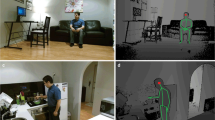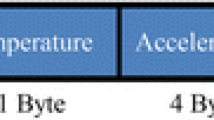Abstract
There has been an increase in the world’s population of elderly persons who wish to live independently for as long as possible. This paper presents an unsupervised approach to help caregivers detect deviations from daily routines of elderly people living alone via inexpensive minimally intrusive sensors. The approach employs a power sensor to measure household composite power consumption and a small number of Kinect sensors in functional areas of the house to capture depth maps from the occupant’s activities of daily living (ADLs). The ADLs in an unlabelled training dataset are identified based on associating the occupant’s locations with specific power signatures on the power line. This training dataset is processed in order to model key features of ADLs, including the regularity and frequency of important activities. The approach uses a novel data-driven technique to define fuzzy sets over ADL attributes tailored to the occupant’s behaviour patterns. The membership functions of these fuzzy sets are learned based on the data distribution of attributes. A set of fuzzy rules is generated to indicate the occupant’s deviation from the normal routine of ADLs in subsequent data. The outputs of this monitoring system are reports on upward and downward deviations from normal behaviour patterns in the form of both numerical and linguistic information. The assessment of these scores over a long-term can help caregivers detect the warning signs of persistent drifts from the daily routine. As a proof of concept, the proposed monitoring approach was evaluated using two datasets collected from real-life settings. The fuzzy rule set obtained from the output of the proposed membership function generation technique was able to effectively monitor the ADLs of elderly people because it could accurately distinguish periods of deviations from the routine performance of ADLs. Compared to existing monitoring techniques, the proposed method required no prior information about the appliances in use and its output was considered to be more helpful for caregivers. The fuzzy inference system in this approach was found to be robust in regard to errors when identifying ADLs as it could effectively classify normal and abnormal behaviour patterns of the occupant despite errors in the list of the used appliances.















Similar content being viewed by others
References
Alcalá J, Parson O, Rogers A (2015) Detecting anomalies in activities of daily living of elderly residents via energy disaggregation and cox processes. In: Proceedings of the 2nd ACM international conference on embedded systems for energy-efficient built environments, ACM, pp 225–234
Banerjee T, Keller JM, Popescu M, Skubic M (2015) Recognizing complex instrumental activities of daily living using scene information and fuzzy logic. Comput Vis Image Underst 140:68–82
Belley C, Gaboury S, Bouchard B, Bouzouane A (2014) An efficient and inexpensive method for activity recognition within a smart home based on load signatures of appliances. Pervasiv Mob Comput 12:58–78
Cho HS, Yamazaki T, Hahn M (2010) AERO: extraction of user’s activities from electric power consumption data. Consumer Electron IEEE Trans 56:2011–2018
Claes V, Devriendt E, Tournoy J, Milisen K (2015) Attitudes and perceptions of adults of 60 years and older towards in-home monitoring of the activities of daily living with contactless sensors: an explorative study. Int J Nurs Stud 52:134–148
Clement J, Ploennigs J, Kabitzsch K (2014) Detecting activities of daily living with smart meters. In: Ambient assisted living, Springer, New York, pp 143–160
Debes C, Merentitis A, Sukhanov S, Niessen M, Frangiadakis N, Bauer A (2016) Monitoring activities of daily living in smart homes: understanding human behavior. IEEE Signal Process Magn 33:81–94
Elbert D, Storf H, Eisenbarth M, Ünalan Ö, Schmitt M (2011) An approach for detecting deviations in daily routine for long-term behavior analysis. In: pervasive computing technologies for healthcare (PervasiveHealth), 2011 5th international conference on, IEEE, pp 426–433
Enno-Edzard S, Thomas F, Marco E, Melina F, Andreas H (2013) Modeling individual healthy behavior using home automation sensor data: results from a field trial. J Ambient Intell Smart Environ 5:503–523
Ester M, Kriegel H-P, Sander J, Xu X (1996) A density-based algorithm for discovering clusters in large spatial databases with noise. In: Kdd, vol 34, pp 226–231
Geng Y, Chen J, Fu R, Bao G, Pahlavan K (2016) Enlighten wearable physiological monitoring systems: on-body RF characteristics based human motion classification using a support vector machine. IEEE Trans Mob Comput 15:656–671. https://doi.org/10.1109/TMC.2015.2416186
Gustafsson L et al (1995) Early clinical manifestations and the course of Alzheimer’s disease related to regional cerebral blood flow and neuropathology. In: Iqbal K, Mortimer JA, Winblad B, Wisniewski HM (eds) Research advances in Alzheimer’s disease and related disorders. Wiley Blackwell, Chichester, UK, pp 209–218
Hasselkus BR (2006) The world of everyday occupation: real people, real lives. Am J Occup Therap 60:627–640
Jos A, Oliver P, Alex R (2015) Detecting anomalies in activities of daily living of elderly residents via energy disaggregation and cox processes. In: Paper presented at the proceedings of the 2nd ACM international conference on embedded systems for energy-efficient built environments, Seoul, South Korea,
Kinect for Windows SDK 2.0 (2015). http://www.microsoft.com/en-au/download/details.aspx?id=44561. Accessed 18 June 2015
Kukolj D (2002) Design of adaptive Takagi–Sugeno–Kang fuzzy models. Appl Soft Comput 2:89–103
Kuok CM, Fu A, Wong MH (1998) Mining fuzzy association rules in databases. ACM Sigmod Record 27:41–46
Lundström J, Järpe E, Verikas A (2016) Detecting and exploring deviating behaviour of smart home residents. Expert Syst Appl 55:429–440
Mamdani EH, Assilian S (1975) An experiment in linguistic synthesis with a fuzzy logic controller. Int J Man Mach Stud 7:1–13. https://doi.org/10.1016/S0020-7373(75)80002-2
Noury N, Berenguer M, Teyssier H, Bouzid MJ, Giordani M (2011) Building an index of activity of inhabitants from their activity on the residential electrical power line. Inf Technol Biomed IEEE Trans 15:758–766
Pazhoumand-Dar H (2017) Fuzzy association rule mining for recognising daily activities using Kinect sensors and a single power meter. J Ambient Intell Hum Comput. https://doi.org/10.1007/s12652-017-0571-8
Pazhoumand-Dar H (2018) FAME-ADL: a data-driven fuzzy approach for monitoring the ADLs of elderly people using Kinect depth maps. J Ambient Intell Hum Comput. https://doi.org/10.1007/s12652-018-0990-1
Peetoom KK, Lexis MA, Joore M, Dirksen CD, De Witte LP (2015) Literature review on monitoring technologies and their outcomes in independently living elderly people. Disabil Rehabil Assist Technol 10:271–294
Pierleoni P, Belli A, Palma L, Pellegrini M, Pernini L, Valenti S (2015) A high reliability wearable device for elderly fall detection. Sens J IEEE 15:4544–4553
Rafferty J, Nugent CD, Liu J, Chen L (2017) From activity recognition to intention recognition for assisted living within smart homes. IEEE Trans Hum Mach Syst 47:368–379. https://doi.org/10.1109/THMS.2016.2641388
Rahimi S, Chan AD, Goubran RA (2011) Usage monitoring of electrical devices in a smart home. In: 2011 Annual international conference of the IEEE engineering in medicine and biology society, IEEE, pp 5307–5310
Ranjan J, Whitehouse K (2015) Rethinking the fusion of technology and clinical practices in functional behavior analysis for the elderly. In: Human behavior understanding, Springer, New York, pp 52–65
Srinivasan V, Stankovic J, Whitehouse K (2013) FixtureFinder: discovering the existence of electrical and water fixtures. In: Proceedings of the 12th international conference on Information processing in sensor networks, ACM, pp 115–128
Suryadevara NK, Mukhopadhyay SC (2015) Sensor activity pattern (SAP) matching process and outlier detection. In: Smart homes, Springer, New York, pp 159–175
Tong Y, Chen R, Gao J (2015) Hidden state conditional random field for abnormal activity recognition in smart homes. Entropy 17:1358
Wilson C, Lina S, Stankovic V, Liao J, Coleman M, Hauxwell-Baldwin R, Kane T, Firth S, Hassan T (2015) Identifying the time profile of everyday activities in the home using smart meter data. Paper presented at the ECEEE-2015 summer study on energy efficiency, Toulon, France
World Health Organization (2015) World report on ageing and health. World Health Organization, Geneva
Xiang Y, Tang Y-P, Ma B-Q, Yan H-C, Jiang J, Tian X-Y (2015) Remote safety monitoring for elderly persons based on Omni-vision analysis. PLoS One 10:e0124068
Author information
Authors and Affiliations
Corresponding author
Additional information
Publisher's Note
Springer Nature remains neutral with regard to jurisdictional claims in published maps and institutional affiliations.
Rights and permissions
About this article
Cite this article
Pazhoumand-Dar, H., Armstrong, L.J. & Tripathy, A.K. Detecting deviations from activities of daily living routines using kinect depth maps and power consumption data. J Ambient Intell Human Comput 11, 1727–1747 (2020). https://doi.org/10.1007/s12652-019-01447-3
Received:
Accepted:
Published:
Issue Date:
DOI: https://doi.org/10.1007/s12652-019-01447-3




